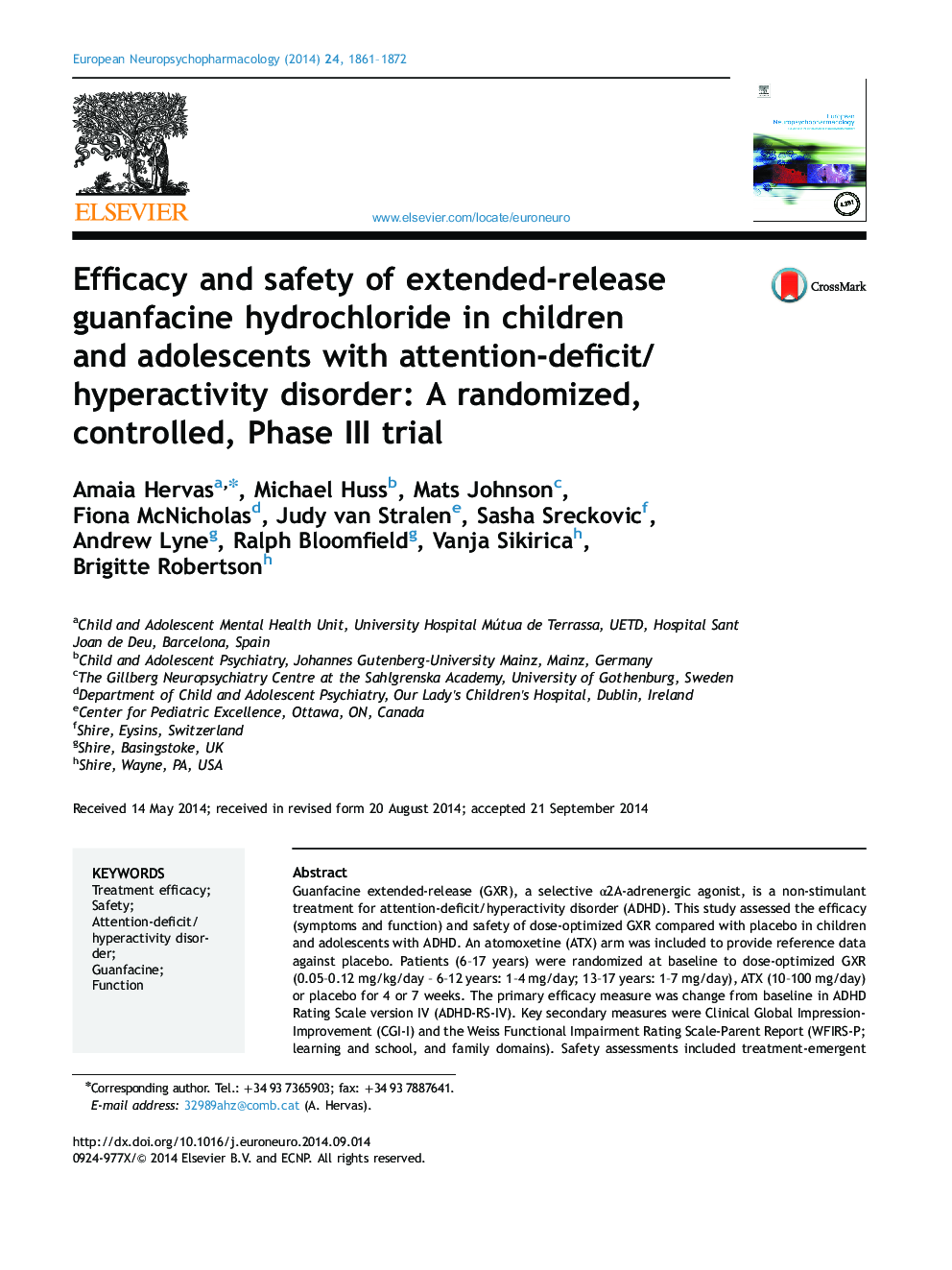| کد مقاله | کد نشریه | سال انتشار | مقاله انگلیسی | نسخه تمام متن |
|---|---|---|---|---|
| 10298687 | 539518 | 2014 | 12 صفحه PDF | دانلود رایگان |
عنوان انگلیسی مقاله ISI
Efficacy and safety of extended-release guanfacine hydrochloride in children and adolescents with attention-deficit/hyperactivity disorder: A randomized, controlled, Phase III trial
دانلود مقاله + سفارش ترجمه
دانلود مقاله ISI انگلیسی
رایگان برای ایرانیان
کلمات کلیدی
موضوعات مرتبط
علوم زیستی و بیوفناوری
علم عصب شناسی
روانپزشکی بیولوژیکی
پیش نمایش صفحه اول مقاله

چکیده انگلیسی
Guanfacine extended-release (GXR), a selective α2A-adrenergic agonist, is a non-stimulant treatment for attention-deficit/hyperactivity disorder (ADHD). This study assessed the efficacy (symptoms and function) and safety of dose-optimized GXR compared with placebo in children and adolescents with ADHD. An atomoxetine (ATX) arm was included to provide reference data against placebo. Patients (6-17 years) were randomized at baseline to dose-optimized GXR (0.05-0.12 mg/kg/day - 6-12 years: 1-4 mg/day; 13-17 years: 1-7 mg/day), ATX (10-100 mg/day) or placebo for 4 or 7 weeks. The primary efficacy measure was change from baseline in ADHD Rating Scale version IV (ADHD-RS-IV). Key secondary measures were Clinical Global Impression-Improvement (CGI-I) and the Weiss Functional Impairment Rating Scale-Parent Report (WFIRS-P; learning and school, and family domains). Safety assessments included treatment-emergent adverse events (TEAEs), electrocardiograms and vital signs. A total of 272 (80.5%) patients from Europe, the USA and Canada completed the study. Significant differences were observed in least squares mean change from baseline in ADHD-RS-IV total score (placebo-adjusted differences) (GXR: [â8.9, p<0.001]; ATX: [â3.8, p<0.05]), the difference from placebo in the percentage of patients showing improvement (1 ['very much improved'] or 2 ['much improved']) for CGI-I (GXR: [23.7, p<0.001]; ATX: [12.1, p<0.05]), WFIRS-P learning and school domain (GXR: [â0.22, p<0.01]; ATX: [â0.16, p<0.05]) and WFIRS-P family domain (GXR: [â0.21, p<0.01]; ATX: [â0.09, p=0.242]). Most common TEAEs for GXR were somnolence, headache and fatigue; 70.1% of GXR subjects reported mild-to-moderate TEAEs. GXR was effective and well tolerated in children and adolescents with ADHD.
ناشر
Database: Elsevier - ScienceDirect (ساینس دایرکت)
Journal: European Neuropsychopharmacology - Volume 24, Issue 12, December 2014, Pages 1861-1872
Journal: European Neuropsychopharmacology - Volume 24, Issue 12, December 2014, Pages 1861-1872
نویسندگان
Amaia Hervas, Michael Huss, Mats Johnson, Fiona McNicholas, Judy van Stralen, Sasha Sreckovic, Andrew Lyne, Ralph Bloomfield, Vanja Sikirica, Brigitte Robertson,